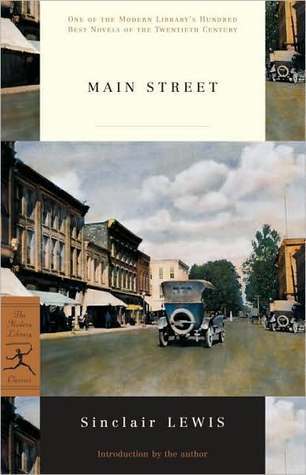
Book Review Summary: Main Street
Introduction
"Main Street" by Sinclair Lewis is a novel that explores the life of an idealistic young woman named Carol Milford as she attempts to reform her small town of Gopher Prairie in Minnesota. Published in 1920, this book gained immediate acclaim and remains one of the essential texts of the American scene. Lewis's portrayal of the rigid and conformist society in Gopher Prairie is both insightful and critical, highlighting the challenges faced by those who seek to bring about change. In this article, we will delve into the views of readers and analyze the reasons why "Main Street" is recommended or not recommended.
About Sinclair Lewis
Sinclair Lewis (1885-1951) was an American author known for his insightful and critical views of American capitalism and materialism between the wars. Born in Sauk Centre, Minnesota, Lewis graduated from Yale in 1907 and went on to become the first American recipient of the Nobel Prize in Literature in 1930. His works, including "Babbitt," "Arrowsmith," "Elmer Gantry," "Dodsworth," and "It Can't Happen Here," are renowned for their ability to create new types of characters and their wit and humor. Lewis's portrayal of modern working women in particular has garnered him praise.
Analysis of Views
-
Realistic portrayal of small-town life: Readers praise Lewis's ability to capture the essence of small-town life in "Main Street." They appreciate the detailed descriptions of the town and its inhabitants, finding it relatable and authentic. The portrayal of the narrow-mindedness, provincialism, bigotry, hypocrisy, self-satisfaction, and resistance to change resonates with readers who have experienced or are familiar with small-town life.
-
Critique of conformity and complacency: Many readers see "Main Street" as a critique of the conformist attitudes and complacency prevalent in small towns. Lewis's portrayal of the rigid social structure and the difficulty of challenging it resonates with readers who have experienced or observed similar situations. The book serves as a reminder that change is often met with resistance and that it can be challenging to break free from societal norms.
-
Strong characterization of women: Lewis is respected for his strong characterizations of modern working women in his novels. In "Main Street," Carol Milford is a protagonist who embodies these qualities. Readers appreciate her intelligence, idealism, and determination to make a difference in her community. They find her struggles relatable and admire her resilience in the face of adversity.
-
Insightful social commentary: Lewis's social commentary in "Main Street" is considered insightful and thought-provoking. He delves into topics such as socialism, feminism, acceptance, and class struggle, offering a critical perspective on American society during the time period. Readers appreciate his ability to delve into complex issues and provide a nuanced understanding of the challenges faced by individuals in small towns.
-
Criticisms of pacing and plot structure: Some readers find that the pacing and plot structure of "Main Street" can be slow and lacking in dramatic tension. They feel that the book relies too heavily on character development and exploration rather than providing a more conventional plot with page-turning drama. This aspect can be seen as both a strength for those who appreciate Lewis's writing style, but also a drawback for those seeking a more action-packed reading experience.
Reasons for Recommendation
-
Insightful exploration of American society: Readers recommend "Main Street" for its insightful exploration of American society during the early 20th century. Lewis's portrayal of small-town life provides a critical lens through which readers can examine their own values and beliefs, leading to introspection and self-reflection.
-
Strong characterization of Carol Milford: Carol Milford's character is widely praised for her intelligence, idealism, and resilience. Readers find her struggles relatable and admire her determination to bring about change in her community. Her character serves as a symbol of hope and inspiration for those who aspire to make a difference in their own lives.
-
Critical social commentary: The social commentary in "Main Street" is considered by many readers to be both insightful and thought-provoking. Lewis's ability to delve into complex issues such as socialism, feminism, acceptance, and class struggle provides readers with a deeper understanding of the challenges faced by individuals in small towns. This aspect makes the book a valuable addition to any literary collection.
Reasons for Not Recommendation
-
Slow pacing and lack of dramatic tension: Some readers find that the pacing and plot structure of "Main Street" can be slow and lacking in dramatic tension. They feel that the book relies too heavily on character development and exploration rather than providing a more conventional plot with page-turning drama. This aspect can be seen as both a strength for those who appreciate Lewis's writing style but also a drawback for those seeking a more action-packed reading experience.
-
Lack of resolution: Some readers feel that the book lacks a clear resolution or satisfying conclusion. They find that Carol's journey towards reforming Gopher Prairie is left unresolved, leaving them with questions about her ultimate success or failure. This aspect can be seen as both a strength for those who appreciate open-ended storytelling but also a drawback for those seeking a more conclusive ending.
Conclusion
"Main Street" by Sinclair Lewis is a novel that explores the challenges faced by an idealistic young woman named Carol Milford as she attempts to reform her small town of Gopher Prairie in Minnesota. The book has garnered praise for its realistic portrayal of small-town life, its insightful social commentary, and its strong characterization of modern working women. However, some readers have criticized the slow pacing and lack of dramatic tension, as well as the lack of resolution in Carol's journey towards reforming Gopher Prairie. Overall, "Main Street" remains an essential text of American literature that continues to resonate with readers today due to its exploration of complex issues and its portrayal of individuals struggling against societal norms and expectations.